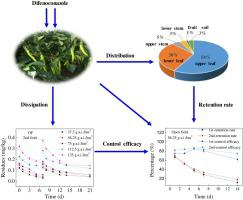Agriculture, Ecosystems & Environment ( IF 6.0 ) Pub Date : 2021-02-24 , DOI: 10.1016/j.agee.2021.107370 Shiyu Chen , Lin Cai , Houpu Zhang , Qianke Zhang , Jiajin Song , Zihan Zhang , Yanfei Deng , Yalei Liu , Xiuguo Wang , Hua Fang

|
The deposition, dissipation, and metabolism of difenoconazole as well as reduced application dose were studied in the open field and greenhouse pepper system. The deposition amount of difenoconazole gradually increased with the increasing dosages, which followed an order with upper leaf > lower leaf > upper stem > lower stem > cultivated soil > fruit. The dissipation half-lives of difenoconazole in different parts of pepper plant and cultivated soil were higher in the greenhouse than those in the open field. Difenoconazole was transformed to metabolite I (C16H13Cl2N3O2) in pepper plant, but metabolite II (C13H14ClN3O3) in cultivated soil. Additionally, the field control efficacy of difenoconazole at the 0.75-fold minimum recommended dosage could meet the basic control requirement after the first application for 7 d. The results revealed deposition distribution and metabolism characteristics of difenoconazole and the application dose may be effectively decreased in the open field and greenhouse pepper-planted ecosystem.
中文翻译:

田间和温室辣椒生态系统中芬尼康唑的沉积分布,代谢特征和减少的施用量
在露天和温室辣椒系统中研究了二苯并康唑的沉积,消散和代谢以及减少的施用量。地芬诺康唑的沉积量随着剂量的增加而逐渐增加,其顺序为上叶>下叶>上茎>下茎>耕地>果实。辣椒植物和耕作土壤中不同部位二苯并康唑的消散半衰期比温室大。Difenoconazole在胡椒植物中被转化为代谢物I(C 16 H 13 Cl 2 N 3 O 2),而代谢物II(C 13 H 14 ClN 3 O 3))。此外,在首次推荐使用7 d后,最小浓度0.75倍的二苯并康唑的田间防治效果可以满足基本防治要求。结果表明,在大田和大棚辣椒种植的生态系统中,二苯并康唑的沉积分布和代谢特性可以有效降低施用量。











































 京公网安备 11010802027423号
京公网安备 11010802027423号